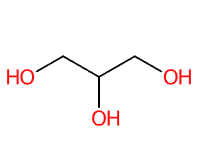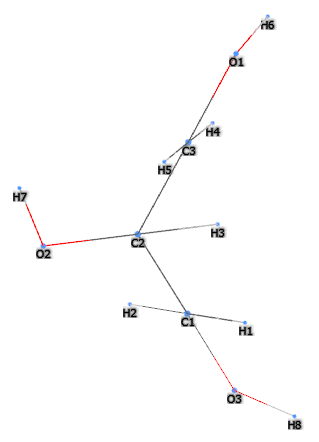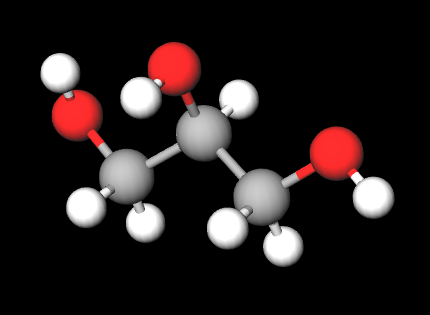| "Descrizione" by FRanier (9971 pt) | 2024-Jan-30 15:41 |
Review Consensus: 10 Rating: 10 Number of users: 1
| Evaluation | N. Experts | Evaluation | N. Experts |
|---|---|---|---|
| 1 | 6 | ||
| 2 | 7 | ||
| 3 | 8 | ||
| 4 | 9 | ||
| 5 | 10 |
Glycerol is a natural three-atom trivalent, hygroscopic alcohol found in the human body, discovered in 1779 by a Swedish scientist named K. W. Scheele while experimenting with a chemical reaction between olive oil and lead monoxide later identified as glycerol.
The name defines the structure of the molecule:
- The name 'glycerol' refers to the three hydroxyl groups (-OH) that make up the molecule.
The synthesis process takes place in different steps:
- Glycerol is often a by-product of the soap production process. When fats or oils (which are triglycerides) are reacted with a strong base such as sodium hydroxide, a process called saponification, the triglycerides are broken down into their component fatty acids and glycerol.
- The fatty acids can react with the base to form soap, while the glycerol can be separated.
- The glycerol thus produced is crude and contains impurities, so it must be purified. This is typically done through a distillation process.
- The end result of this process is pure glycerol.
Glycerin is the trade name when the percentage of glycerol is 95%, but the names are mostly used to identify the same product. In other words: the pure chemical component is called glycerol, while glycerine contains about 95 per cent glycerol.
It occurs as an odourless, colourless to brown viscous liquid. Insoluble in chloroform, ether, carbon disulphide, benzene, oil. Miscible with ethanol and water. Can absorb moisture from the air as well as other volatile chemicals such as hydrogen sulphide, hydrogen cyanide and sulphur dioxide.

What it is used for and where it is used
There are approximately 1,600 applications for glycerol.
Medical
Since 1961, glycerol has been used in the treatment of intracranial hypertension, glaucoma, cerebral oedema resulting from acute ischaemic stroke, and rehydration to improve tolerance to many heat-related stressors involving exercise. Glycerol has been used as a lubricant in cases of dry mouth, in cataract surgery and acts as an osmotic dehydrating agent that has effects on brain metabolism by decreasing intracranial pressure at certain doses, reducing intraocular pressure in glaucoma and has proved very useful during neurosurgical procedures on the brain (1).
Food
- Hygroscopic agent, sweetener and solvent. Labelled E422 on the European food additives list as an emulsifier. Glycerol can be converted to monolaurate glycerol used in the food industry as a preservative, surfactant, and emulsifier. Emulsifiers have the property of reducing interfacial tension and also directly influence the stability, sensory properties and surface tension of sunscreens by modulating their filmometric performance. Glycerol is used to make glycerol mono oleate, a product of glycerolysis of camellia oil with the help of lipase as a catalyst that has been used in the production of ice cream.
Military
- Preparation of nitroglycerine, an explosive. Anticorrosive agent
Pharmaceutical
- Syrups, suppository ointments as humectant, lubricant. Inserted in medicinal tablets as a humectant and flow agent.
Cosmetics
Its water solubility, hygroscopicity and hydrophilicity characteristics give glycerol humectant and moisturising capabilities that are of great importance in most topical cosmetic applications. By improving skin texture, it acts as a skin barrier. In cleansers, shampoos and other cosmetic products, it is included in the formula with the aim of moisturising and softening the skin, preserving it from ageing or roughness. It is also used in toothpastes as a humectant and to protect gum and tooth tissue.
- Denaturant. The ionic or polar molecules of this ingredient included in formulations that interact with protein groups, modulate the properties of the solution to suit specific needs.
- Hair conditioning agent. A significant number of ingredients with specific and targeted purposes may co-exist in hair shampoo formulations: cleansers, conditioners, thickeners, matting agents, sequestering agents, fragrances, preservatives, special additives. However, the indispensable ingredients are the cleansers and conditioners as they are necessary and sufficient for hair cleansing and manageability. The others act as commercial and non-essential auxiliaries such as: appearance, fragrance, colouring, etc. Hair conditioning agents have the task of increasing shine, manageability and volume, and reducing static electricity, especially after treatments such as colouring, ironing, waving, drying and brushing. They are, in practice, dispersants that may contain cationic surfactants, thickeners, emollients, polymers. The typology of hair conditioning agents includes: intensive conditioners, instant conditioners, thickening conditioners, drying conditioners. They can perform their task generally accompanied by other different ingredients.
- Humectant. Hygroscopic compound used to minimise water loss in the skin and to prevent it from drying out by facilitating faster and greater absorption of water into the stratum corneum of the epidermis. The epidermis is the most superficial of the three layers that make up human skin (epidermis, dermis and hypodermis) and is the layer that maintains hydration in all three layers. In turn, the epidermis is composed of five layers: horny, the most superficial, granular, spinous, shiny, and basal. Humectants have the ability to retain the water they attract from the air in the stratum corneum and have the function of moisturising the skin. They are best used before emollients, which are oil-based.
- Oral care agent. This ingredient can be placed in the oral cavity to improve and/or maintain oral hygiene and health, to prevent or improve a disorder of the teeth, gums, mucous membrane.
- Perfuming. Unlike fragrance, which can also contain slightly less pleasant or characteristic odours, the term perfume indicates only very pleasant fragrances.
- Skin conditioning agent. It is the mainstay of topical skin treatment as it has the function of restoring, increasing or improving skin tolerance to external factors, including melanocyte tolerance. The most important function of the conditioning agent is to prevent skin dehydration, but the subject is rather complex and involves emollients and humectants that can be added in the formulation.
- Skin protectant. It creates a protective barrier on the skin to defend it from harmful substances, irritants, allergens, pathogens that can cause various inflammatory conditions. These products can also improve the natural skin barrier and in most cases more than one is needed to achieve an effective result.
- Solvent. It is the substance for dissolving or dispersing surfactants, oils, dyes, flavourings, bactericidal preservatives in solution.
- Viscosity control agent. It controls and adapts viscosity to the required level for optimal chemical and physical stability of the product and dosage in gels, suspensions, emulsions, solutions.
Textile industry
- Finishing techniques, co-solvent, dispersant, moisture absorbent. Wetting agent, hygroscopic agent, anti-shrinkage treatment of fabrics.
Coatings
- Alkyd resin (modified thermosetting polyester), polyester resin, epoxy resin and glycidyl ether.
and also: papermaking, in leather, photography, metalworking, rubber, printing and dyeing, antifreeze in lubricants and the petroleum sector.
Sport
- The use of orally or intravenously administered glycerol has been prohibited.
The most relevant studies on this ingredient have been selected with a summary of their contents:
Typical optimal commercial product characteristics Glycerol
| Appearance | Colorless to brown colored liquid |
| Boiling Point | 290.0±0.0 °C at 760 mmHg |
| Melting Point | 17.8℃(18.17℃,20℃) |
| Density | 1.3±0.1 g/cm3 1.26331 (20 ºC) |
| pH | 5.5-8 (25℃, 5M in H2O) |
| Flash Point | 160.0±0.0 °C |
| Relative vapor density (air = 1) | 3.1 |
| Viscosity (20 ºC) : 1412 mpa. S (25 ºC) | 945 mpa. S |
| Surface tension (20 ºC) | 63.3 mN/m |
| Saturated vapor pressure (kPa) | 0.4 (20 ºC) |
| Ignition temperature | 370° |
| Volume expansion coefficient/K - 1 | 0.000615 |
| Saponification equivalent | ≤5mg/kg |
| Heavy metals | ≤2mg/kg |
| Refractive Index | 1.47547~1.4730 |
 |  |
 |  |
- Molecular Formula : C3H8O3 C3H5(OH)3 CH2OH-CHOH-CH2OH
- Linear Formula : HOCH2CH(OH)CH2OH
- PMolecular Weight : 92.094 g/mol
- Exact Mass 92.047340
- CAS : 56-81-5 8043-29-6 25618-55-7 8013-25-0
- UNII PDC6A3C0OX
- EC Number: 200-289-5
- MDL number: MFCD00004722
- PubChem Substance ID: 24895216
- DSSTox Substance ID DTXSID9020663 DTXSID4020662
- IUPAC propane-1,2,3-triol
- InChI=1S/C3H8O3/c4-1-3(6)2-5/h3-6H,1-2H2
- InChl Key PEDCQBHIVMGVHV-UHFFFAOYSA-N
- SMILES C(C(CO)O)O
- ChEBI 17754
- ICSC 0624
- NSC 759633 9230
- RTECS MA8050000
- NCI C29077
Synonyms:
- propan-1,2,3-triol
- Glycerin
- Glycerine
- Glycyl alcohol
- 1,2,3-trihydroxypropane
- 1,2,3-Propanetriol
- Synthetic glycerin
- Polyglycerine
References_____________________________________________________________________
(1) Frank MS, Nahata MC, Hilty MD. Glycerol: a review of its pharmacology, pharmacokinetics, adverse reactions, and clinical use. Pharmacotherapy. 1981 Sep-Oct;1(2):147-60. doi: 10.1002/j.1875-9114.1981.tb03562.x.
| Evaluate |

